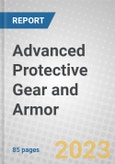The protective clothing, gear and armor markets represent a fragmented industry. There are significant and specific segments of the protective clothing, gear and armor industry. Within each of these segments are a variety of players, including government organizations that create, develop and enforce regulations and standards, raw material suppliers, fiber and fabric manufacturers, mills and fabric producers, finished goods manufacturers and suppliers and distributors. As a result of the complexity, supply chains sometimes may be difficult to understand.
This report focuses on the major material types and the designers of the products instead of on product distributors. One large corporation, through many of its parts, may be involved in all sectors of the supply chain.
This study focuses on the following major sectors of the global advanced protective gear and armor market -
- Heat and flame-resistant clothing, including firefighters’ turnout gear for structural, proximity and wildlands fire service, as well as industrial fire-resistant garments for use in electric and gas utilities or in industrial applications in which electric arc and flash fire are hazards.
- Chemical protective garments and equipment, including chemical-resistant clothing, chemical or biological warfare and protective suits and gloves used in industrial applications. Much of this same gear can be used for biological protection.
- Respirators and ancillary components for fire and chemical/biological situations.
- Body and vehicular armor, including bullet and fragmentation-resistant garments used in law enforcement and military applications.
- Body armor, including bullet-resistant garments used in law enforcement and military applications. This includes the retrofitting of vehicles using the same types of materials and some of the newer engineered in-place vehicle armor.
- Sports protective gear is excluded in this report.This report discusses the chemical/biological, fire and projectiles/explosives segments, including the regulations, raw materials, technologies, market size and anticipated growth. Manufacturers are evaluated and listed at the conclusion of each of the appropriate sections.
The market estimates and forecasts are based on a thorough analysis of the annual sales, market dynamics, product penetration as well as several other factors.
Nuclear protective gear is excluded from discussion because no truly protective clothing exists for severe nuclear threats such as battlefield nuclear explosions or Chernobyl-level nuclear accidents. Respirators and clothing can help, but the best solution is situational awareness.
Report Includes
- 16 data tables and 10 additional tables
- An up-to-date review and industry analysis of the global advanced protective gear and armor
- fire resistance market
- Analyses of the global market trends, with historic market revenue (sales figures) for 2022, estimates for 2023, and projections of compound annual growth rates (CAGRs) through 2028
- Estimation of the actual market size and revenue forecast for global advanced protective gear and armor
- fire resistance market, and corresponding market share analysis based on type, end use sector, and region
- In-depth information (facts and figures) of the major market dynamics (DROs), emerging trends, technology updates, industry-specific regulations, and macroeconomic variables influencing the market demand over the next few years (2023-2028)
- Identification of the companies best positioned to meet this demand owing to or in conjunction with their proprietary technologies, product launches, and other strategic advantages
- Discussion of value chain analysis in the advanced protective gear and armor-fire resistance market providing a systematic study of key intermediaries involved, with emphasis on raw materials suppliers and major types of end-users
- Analysis of market growth opportunities with a holistic review of the Porter’s five forces analysis and PESTLE analysis considering both micro
- and macro environmental factors prevailing in the market
- A look at the major protective glove manufacturers and analyze the structure of advanced protective gear and armor
- fire resistance industry (e.g., market shares, concentration and recent merger and acquisition (M&A) activity)
- Review of the key patent grants and recent patent applications on advanced protective gear and armor
- fire resistance market, with emphasis on upcoming technologies and new developments within the industry
- Identification of the key players operating in the market, and analysis of their competitive landscape based on recent developments, segmental revenues, and operational integration
- Company profiles of major players within the industry, including 3M, ArmorSource, Avon Protection DuPont, and Honeywell
Table of Contents
Executive Summary
This market research report focuses on protective gear, clothing and armor worn by personnel in law enforcement, the military, fire services and all other first responders and industrial workers.The largest single sector of this market includes ancillary components such as protective gloves, helmets, eye wear and respirators. Many industrial or utility workers may need only minimal protection as compared to the more expensive and complex bunker gear of firefighters. Bunker gear, often known as turnout gear, is the personal protective equipment (PPE) firefighters are required to wear on the job.
CBRN is the fastest-growing segment within the global market during the forecast period.
Companies Mentioned
- 3M Co.
- Armorsource Llc
- Avon Protection Plc
- Bae Systems Plc
- Dupont
- Honeywell International Inc.
- Kimberly Clark Professional
- Msa Safety Inc.
- Point Blank Enterprises Inc.
Table Information
| Report Attribute | Details |
|---|---|
| No. of Pages | 85 |
| Published | November 2023 |
| Forecast Period | 2023 - 2028 |
| Estimated Market Value ( USD | $ 11.4 Billion |
| Forecasted Market Value ( USD | $ 15.4 Billion |
| Compound Annual Growth Rate | 6.3% |
| Regions Covered | Global |
| No. of Companies Mentioned | 9 |









